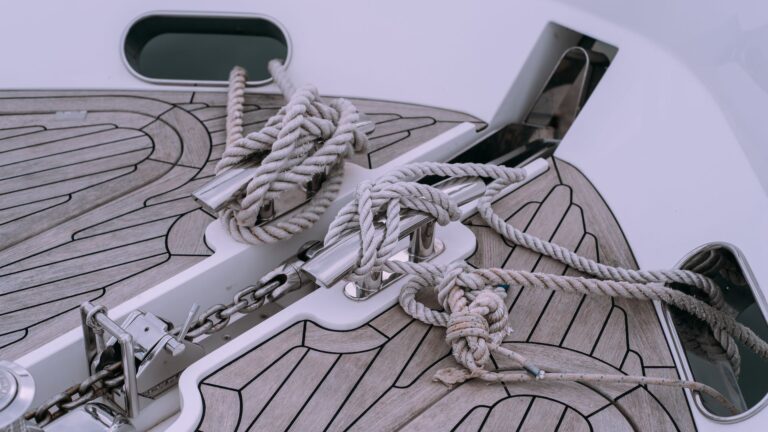How many knots is best for sailing?
- Introduction
- What is a Knot?
- Ideal Conditions for Sailing
- Benefits of Sailing in 5-12 Knots
- What Happens Below 5 Knots?
- Examples of Sailing below 5 Knots
- How to Increase Speed in Light Winds
- Alternative Ways to Power the Boat in Light Winds
- Tips and Tricks for Sailing in Light Winds
- Different Types of Sailboats and their Optimal Speeds
- Conclusion
How Many Knots is Best for Sailing?
Sailing is one of the oldest and most popular forms of transportation and recreation, but what is the best wind speed for sailing? The answer may surprise you: the optimal wind speed for sailing is between 5 and 12 knots! Keep reading to learn more about why this is the ideal range and how to make the most out of sailing even in light winds below 5 knots!
What is a Knot?
A knot is a unit of speed used to measure the rate of movement through water, equal to one nautical mile per hour (1 nautical mile = 1.15 statute miles). This means that if you are traveling at a speed of 10 knots, you are going 10 nautical miles per hour or 11.5 statute miles per hour!
Ideal Conditions for Sailing
When talking about sailing, there is no one “perfect” wind speed as every boat has its own optimal range for different kinds of sailing activities; however, most sailors find that between 5 and 12 knots offers the best sailing experience overall! This range provides enough wind power to fill sails while still providing a comfortable ride that doesn’t require too much effort from the sailor!
Benefits of Sailing in 5-12 Knots
Sailing in winds between 5-12 knots offers many benefits, including maneuverability, stability, control and less fatigue from trying to sail against strong winds! In this range, boats can be easily maneuvered around obstacles or into tight spaces without fear of capsizing; they can also maintain a steady course without being buffeted by strong gusts or waves! Additionally, when sailing with these speeds it’s easy to keep control over your boat by using sails and other equipment like rudders or mainsheets without having to fight against powerful winds! Finally, when sailing in this range you can save energy by not having to constantly compensate for strong gusts or waves which will mean less fatigue at the end of your voyage!
What Happens Below 5 Knots?
When sailing with light winds below 5 knots it can be difficult to maintain control over your boat due to its lack of power; additionally, it may be hard to maneuver around obstacles or into tight spaces as there won’t be enough wind power to fill sails properly! However, there are ways to make sailing more enjoyable even in light winds below 5 knots; read on for more information on how you can do this!
## Examples of Sailing Below 5 Knots
One example of successfully sailing with light winds below 5 knots can be seen from sailors on smaller boats such as dinghies or catamarans who have mastered techniques such as luffing (which involves adjusting sail shape) or using momentum from waves for added speed; these techniques allow them to make use even out of light winds by taking advantage of their smaller size and lighter weight! Additionally, some sailors have been able to sail upwind with speeds as low as 3 knots by exploiting ocean currents or prevailing breezes which helps them maintain their course even when there isn’t much wind power available!
## How To Increase Speed In Light Winds
When sailing with light winds below 5 knots it can be difficult to maintain your desired course or keep up with other boats; however, there are some ways you can increase your speed even in these conditions such as reefing (reducing sail area) or using spinnakers (specialized sail shapes) which help increase lift force from air currents; additionally, using an engine allows you to maintain a steady course and cruise at a comfortable pace regardless of wind strength!
## Alternative Ways To Power The Boat In Light Winds
In addition to using an engine for powering your boat when there isn’t enough wind power available, some sailors have also experimented with alternative ways such as kitesurfing (using kites attached to sails) or electric motors which are both capable of propelling boats even when there isn’t much wind around!
## Tips And Tricks For Sailing In Light Winds
If you want to make sure you get the most out of your sailing experience even when dealing with light winds below 5 knots then here are some tips and tricks that may help: firstly try reefing (reducing sail area); secondly adjust your sail shape according to changing conditions; finally look out for any ocean currents or prevailing breezes that may help give an extra boost!
## Different Types Of Sailboats And Their Optimal Speeds
Different types of sailboats have different optimal speeds depending on their size, weight and type; generally speaking larger boats require stronger winds while smaller boats may perform better in lighter breezes; also certain designs like catamarans may require less wind than monohull designs due to their wider surface area and increased stability which means they can cruise comfortably even when there isn’t much wind around them!
## Conclusion
In conclusion we can see that when it comes to sailing the optimal wind speed is between 5-12knots as this offers enough power for maneuverability while still providing a comfortable ride that doesn’t require too much effort from the sailor; however if you ever find yourself dealing with light winds below5knots then don’t worry – just employ some alternative methods such as reefing/spinnakers/electric motors/kitesurfing etc., use tips & tricks like adjusting sail shape accordingto changing conditions & look outfor any ocean currents/breezesthat may give an extra boost –andyou should be ableto enjoya relaxing &enjoyable voyage regardlessofwind strength !







